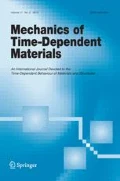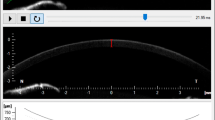Abstract
Non-contact tonometers, including ORA and Corvis ST, are not only used to estimate intraocular pressure (IOP) in clinical surveys but are also utilized to evaluate biomechanical properties of the cornea or anterior eye. However, for the cornea a realistic material model is still a controversial issue, and the main goal of the present study is to make this clearer. To this aim, the corneal biomechanical response is modeled by using a four-element linear viscoelastic model, which is characterized by in-vivo clinical data from Corvis ST tonometer. IOP tonometry tests on 5 normal and 5 keratoconic cases are accomplished by Corvis ST tonometer. Images from cornea deformation due to applied air jet are acquired from Corvis ST and are converted to the corneal deformation profiles by image processing techniques. By excluding the eye globe rigid body motion (retraction) from the total eye displacement, pure deformation of the cornea is obtained and used to calculate the required material properties. By calculating retardation time, contribution of the material viscosity during the test is estimated. The results show that viscosity effects do not substantially contribute to the cornea response during dynamic tests for both normal and keratoconic corneas. Indeed, the viscous effect comes from the eye globe rigid body motion.









Similar content being viewed by others
References
Ariza-Gracia, M.Á., Zurita, J.F., Piñero, D.P., Rodriguez-Matas, J.F., Calvo, B.: Coupled biomechanical response of the cornea assessed by non-contact tonometry. A simulation study. PLoS ONE 10(3), e0121,486 (2015). https://doi.org/10.1371/journal.pone.0121486
Ariza-Gracia, M.Á., Redondo, S., Llorens, D.P., Calvo, B., Matas, J.F.R.: A predictive tool for determining patient-specific mechanical properties of human corneal tissue. Comput. Methods Appl. Mech. Eng. 317, 226–247 (2017). https://doi.org/10.1016/j.cma.2016.12.013
Boyce, B., Jones, R., Nguyen, T., Grazier, J.: Stress-controlled viscoelastic tensile response of bovine cornea. J. Biomech. 40(11), 2367–2376 (2007). https://doi.org/10.1016/j.jbiomech.2006.12.001
Brinson, H.F., Brinson, L.C.: Polymer Engineering Science and Viscoelasticity. Springer, Berlin (2008). https://doi.org/10.1007/978-0-387-73861-1
Bryant, M.R., McDonnell, P.J.: Constitutive laws for biomechanical modeling of refractive surgery. J. Biomech. Eng. 118(4), 473–481 (1996). https://doi.org/10.1115/1.2796033
Eilaghi, A., Flanagan, J.G., Tertinegg, I., Simmons, C.A., Brodland, G.W., Ethier, C.R.: Biaxial mechanical testing of human sclera. J. Biomech. 43(9), 1696–1701 (2010). https://doi.org/10.1016/j.jbiomech.2010.02.031
Elsheikh, A., Anderson, K.: Comparative study of corneal strip extensometry and inflation tests. J. R. Soc. Interface 2(3), 177–185 (2005). https://doi.org/10.1098/rsif.2005.0034
Elsheikh, A., Alhasso, D., Rama, P.: Biomechanical properties of human and porcine corneas. Exp. Eye Res. 86(5), 783–790 (2008). https://doi.org/10.1016/j.exer.2008.02.006
Farandos, N.M., Yetisen, A.K., Monteiro, M.J., Lowe, C.R., Yun, S.H.: Contact lens sensors in ocular diagnostics. Adv. Healthc. Mater. 4(6), 792–810 (2015). https://doi.org/10.1002/adhm.201400504
Fraldi, M., Cutolo, A., Esposito, L., Guarracino, F.: The role of viscoelasticity and stress gradients on the outcome of conductive keratoplasty. Biomech. Model. Mechanobiol. 10(3), 397–412 (2011). https://doi.org/10.1007/s10237-010-0242-6
Fraldi, M., Cutolo, A., Esposito, L., D’Amore, A.: Visco-elastic and thermal-induced damaging in time-dependent reshaping of human cornea after conductive keratoplasty. Mech. Time-Depend. Mater. 21(1), 45–59 (2016). https://doi.org/10.1007/s11043-016-9317-9
Glass, D.H., Roberts, C.J., Litsky, A.S., Weber, P.A.: A viscoelastic biomechanical model of the cornea describing the effect of viscosity and elasticity on hysteresis. Investig. Ophthalmol. Vis. Sci. 49(9), 3919–3926 (2008). https://doi.org/10.1167/iovs.07-1321
Han, Z., Tao, C., Zhou, D., Sun, Y., Zhou, C., Ren, Q., Roberts, C.J.: Air puff induced corneal vibrations: theoretical simulations and clinical observations. J. Refract. Surg. 30(3), 208–213 (2014). https://doi.org/10.3928/1081597x-20140212-02
Jannesari, M., Kadkhodaei, M., Mosaddegh, P., Kasprzak, H., Jabbarvand Behrouz, M.: Assessment of corneal and fatty tissues biomechanical response in dynamic tonometry tests by using inverse models. Acta Bioeng. Biomech. 20(1), 39–48 (2018). https://doi.org/10.5277/ABB-00969-2017-02
Kling, S., Bekesi, N., Dorronsoro, C., Pascual, D., Marcos, S.: Corneal viscoelastic properties from finite-element analysis of in vivo air-puff deformation. PLoS ONE 9(8), e104,904 (2014). https://doi.org/10.1371/journal.pone.0104904
Kok, S., Botha, N., Inglis, H.M.: Calibrating corneal material model parameters using only inflation data: an ill-posed problem. Int. J. Numer. Methods Biomed. Eng. 30(12), 1460–1475 (2014). https://doi.org/10.1002/cnm.2667
Koprowski, R., Kasprzak, H., Wróbel, Z.: New automatic method for analysis and correction of image data from the Corvis tonometer. Comput. Methods Biomech. Biomed. Eng. Imaging Vis., 1–9 (2014a). https://doi.org/10.1080/21681163.2014.959137
Koprowski, R., Lyssek-Boron, A., Nowinska, A., Wylegala, E., Kasprzak, H., Wrobel, Z.: Selected parameters of the corneal deformation in the Corvis tonometer. Biomed. Eng. Online 13(1), 1–16 (2014b). https://doi.org/10.1186/1475-925X-13-55
Lago, M., Rupérez, M., Martínez-Martínez, F., Monserrat, C., Larra, E., Güell, J., Peris-Martínez, C.: A new methodology for the in vivo estimation of the elastic constants that characterize the patient-specific biomechanical behavior of the human cornea. J. Biomech. 48(1), 38–43 (2015). https://doi.org/10.1016/j.jbiomech.2014.11.009
Liu, J., Roberts, C.J.: Influence of corneal biomechanical properties on intraocular pressure measurement: quantitative analysis. J. Cataract Refract. Surg. 31(1), 146–155 (2005). https://doi.org/10.1016/j.jcrs.2004.09.031
Luce, D.A.: Determining in vivo biomechanical properties of the cornea with an ocular response analyzer. J. Cataract Refract. Surg. 31(1), 156–162 (2005). https://doi.org/10.1016/j.jcrs.2004.10.044
Matalia, J., Francis, M., Tejwani, S., Dudeja, G., Rajappa, N., Roy, A.S.: Role of age and myopia in simultaneous assessment of corneal and extraocular tissue stiffness by air-puff applanation. J. Refract. Surg. 32(7), 486–493 (2016). https://doi.org/10.3928/1081597x-20160512-02
Piñero, D.P., Alcón, N.: In vivo characterization of corneal biomechanics. J. Cataract Refract. Surg. 40(6), 870–887 (2014). https://doi.org/10.1016/j.jcrs.2014.03.021
Roy, A.S., Rocha, K.M., Randleman, J.B., Stulting, R.D., Duppsad, W.J.: Inverse computational analysis of in vivo corneal elastic modulus change after collagen crosslinking for keratoconus. Exp. Eye Res. 113, 92–104 (2013). https://doi.org/10.1016/j.exer.2013.04.010
Roy, A.S., Kurian, M., Matalia, H., Shetty, R.: Air-puff associated quantification of non-linear biomechanical properties of the human cornea in vivo. J. Mech. Behav. Biomed. Mater. 48, 173–182 (2015). https://doi.org/10.1016/j.jmbbm.2015.04.010
Ruberti, J.W., Sinha Roy, A., Roberts, C.J.: Corneal biomechanics and biomaterials. Annu. Rev. Biomed. Eng. 13, 269–295 (2011). https://doi.org/10.1146/annurev-bioeng-070909-105243
Sánchez, P., Moutsouris, K., Pandolfi, A.: Biomechanical and optical behavior of human corneas before and after photorefractive keratectomy. J. Cataract Refract. Surg. 40(6), 905–917 (2014). https://doi.org/10.1016/j.jcrs.2014.03.020
Shah, S., Laiquzzaman, M., Bhojwani, R., Mantry, S., Cunliffe, I.: Assessment of the biomechanical properties of the cornea with the ocular response analyzer in normal and keratoconic eyes. Investig. Ophthalmol. Vis. Sci. 48(7), 3026–3031 (2007). https://doi.org/10.1167/iovs.04-0694
Simonini, I., Pandolfi, A.: Customized finite element modelling of the human cornea. PLoS ONE 10(6), e0130,426 (2015a). https://doi.org/10.1371/journal.pone.0130426
Simonini, I., Pandolfi, A.: The influence of intraocular pressure and air jet pressure on corneal contactless tonometry tests. J. Mech. Behav. Biomed. Mater. (2015b). https://doi.org/10.1016/j.jmbbm.2015.07.030
Simonini, I., Angelillo, M., Pandolfi, A.: Theoretical and numerical analysis of the corneal air puff test. J. Mech. Phys. Solids 93, 118–134 (2016). https://doi.org/10.1016/j.jmps.2016.04.012
Vinciguerra, R., Ambrósio, R., Elsheikh, A., Roberts, C.J., Lopes, B., Morenghi, E., Azzolini, C., Vinciguerra, P.: Detection of keratoconus with a new biomechanical index. J. Refract. Surg. 32(12), 803–810 (2016). https://doi.org/10.3928/1081597x-20160629-01
Acknowledgements
The authors are grateful to Reza Ghaffari, MD (Farabi hospital, Tehran, Iran), Soheila Asgari, MD (Ophthalmology Research Center, Noor Eye Hospital, Tehran, Iran), and Hesam Hashemian, MD (Farabi hospital, Tehran, Iran) for collecting Corivs ST data from Noor Ophthalmology Research Center, Noor Eye Hospital, Tehran, Iran. Ali R Djalilian, MD (Department of Ophthalmology and Visual Sciences, University of Illinois at Chicago, IL) is acknowledged for his courtesy and precious comments on the present work.
Author information
Authors and Affiliations
Corresponding author
Rights and permissions
About this article
Cite this article
Jannesari, M., Mosaddegh, P., Kadkhodaei, M. et al. Numerical and clinical investigation on the material model of the cornea in Corvis tonometry tests: differentiation between hyperelasticity and viscoelasticity. Mech Time-Depend Mater 23, 373–384 (2019). https://doi.org/10.1007/s11043-018-9390-3
Received:
Accepted:
Published:
Issue Date:
DOI: https://doi.org/10.1007/s11043-018-9390-3




